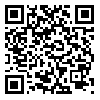Volume 23, Issue 6 (2-2025)
TB 2025, 23(6): 78-91 |
Back to browse issues page
Ethics code: IR.MUQ.REC.1403.091
Download citation:
BibTeX | RIS | EndNote | Medlars | ProCite | Reference Manager | RefWorks
Send citation to:



BibTeX | RIS | EndNote | Medlars | ProCite | Reference Manager | RefWorks
Send citation to:
aligol M, Golzadeh F, Kermani S. Investigating The Effect of Education Based On hHealth Belief model On Predictive Factors of Breast Self-Examination In Women In Qom City In 2024. TB 2025; 23 (6) :78-91
URL: http://tbj.ssu.ac.ir/article-1-3715-en.html
URL: http://tbj.ssu.ac.ir/article-1-3715-en.html
Qom University of Medical Sciences and Health Services , aligol1389@gmail.com
Abstract: (575 Views)
Introduction: Breast cancer is the most common cancer among women. Women who perform breast self-examination monthly are more likely to find lumps in the early stages. This study was designed and implemented to investigate the effect of education based on health belief model on predictive factors of breast self-examination in women in Qom.
Methods: This semi-experimental study was conducted on 70 women referring to comprehensive health service centers in Qom in November and December 2024, divided into experimental and control groups. The data collection tool included demographic questions and the Persian version of the Champion’s Health Belief Model questionnaire. The educational intervention consisted of three educational sessions designed based on the constructs of the health belief model. Post-test data were collected three months after the intervention. Paired t-tests were used to compare each group before and after the intervention.
Results: Paired T-test showed significant differences in mean and standard deviation of scores of all health
belief model constructs including perceived sensitivity, perceived severity, perceived benefits, health
motivation, perceived self-efficacy, and behavioral intention showed significant differences in mean and standard deviation of scores before and after the educational intervention (p<0/05). In the control group, no significant differences were observed in any of the constructs before and after the intervention.
Conclusion: The use of appropriate educational methods based on the health belief model significantly improves the predictive factors of breast self-examination. Given the easy and inexpensive nature of these interventions and considering the implementation, cultural, and organizational constraints, this can be widely considered to increase equitable access to education and facilitate diagnosis and treatment.
Conflict of interest: The authors declared no conflict of interest
Methods: This semi-experimental study was conducted on 70 women referring to comprehensive health service centers in Qom in November and December 2024, divided into experimental and control groups. The data collection tool included demographic questions and the Persian version of the Champion’s Health Belief Model questionnaire. The educational intervention consisted of three educational sessions designed based on the constructs of the health belief model. Post-test data were collected three months after the intervention. Paired t-tests were used to compare each group before and after the intervention.
Results: Paired T-test showed significant differences in mean and standard deviation of scores of all health
belief model constructs including perceived sensitivity, perceived severity, perceived benefits, health
motivation, perceived self-efficacy, and behavioral intention showed significant differences in mean and standard deviation of scores before and after the educational intervention (p<0/05). In the control group, no significant differences were observed in any of the constructs before and after the intervention.
Conclusion: The use of appropriate educational methods based on the health belief model significantly improves the predictive factors of breast self-examination. Given the easy and inexpensive nature of these interventions and considering the implementation, cultural, and organizational constraints, this can be widely considered to increase equitable access to education and facilitate diagnosis and treatment.
Conflict of interest: The authors declared no conflict of interest
Type of Study: Research |
Subject:
other
Received: 2024/09/10 | Accepted: 2024/12/11 | Published: 2025/02/28
Received: 2024/09/10 | Accepted: 2024/12/11 | Published: 2025/02/28
Send email to the article author
| Rights and permissions | |
 |
This work is licensed under a Creative Commons Attribution-NonCommercial 4.0 International License. |







